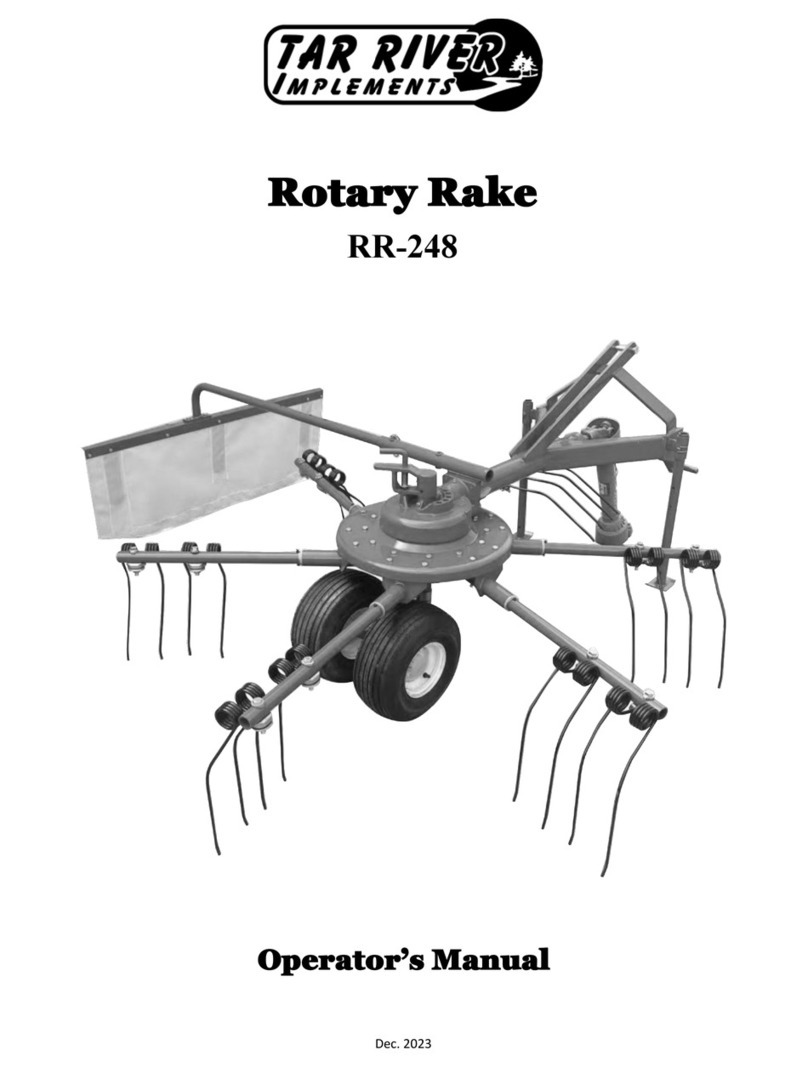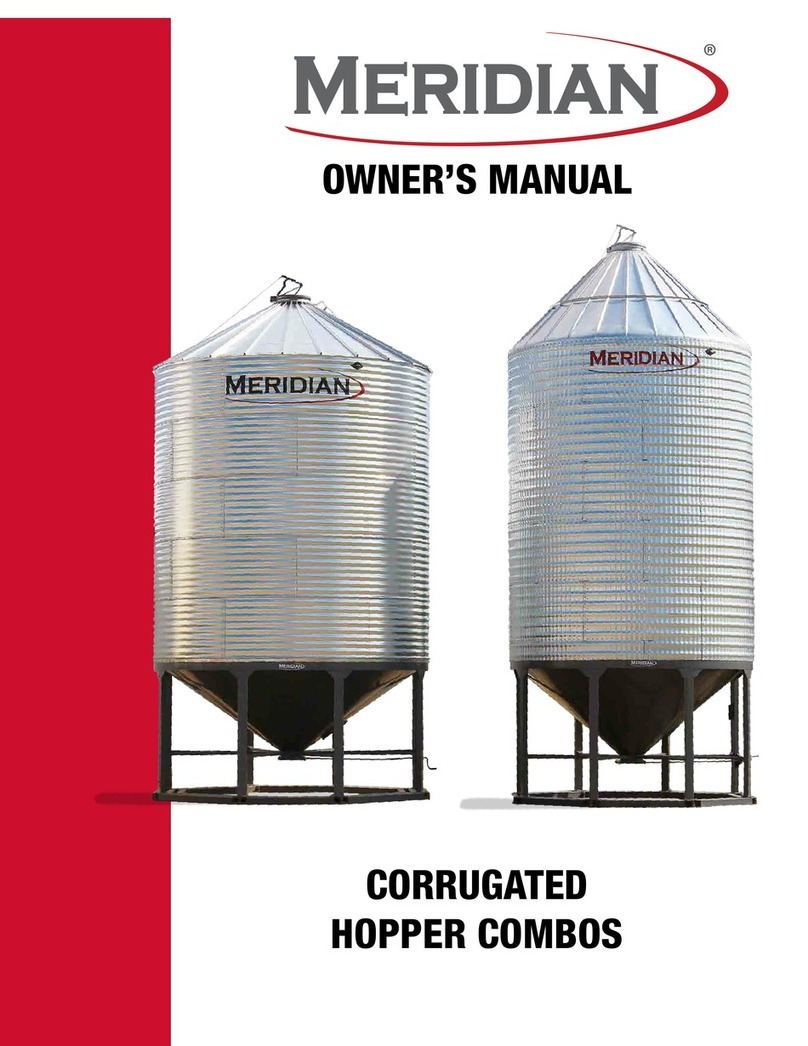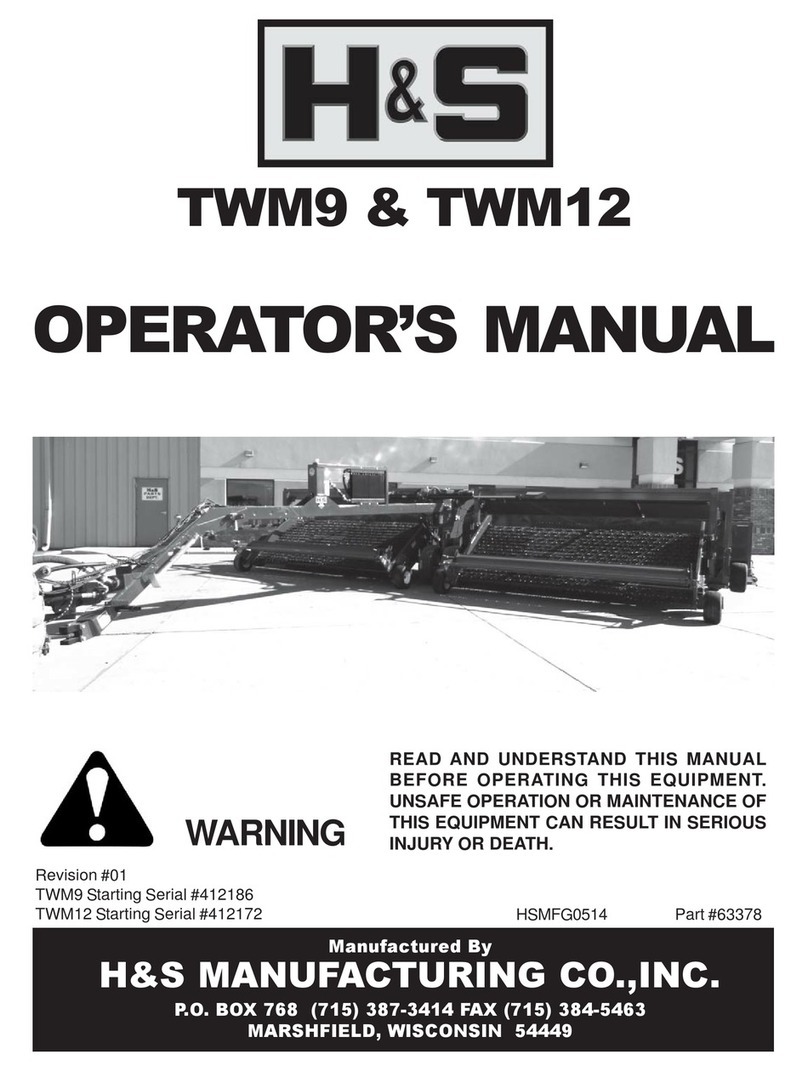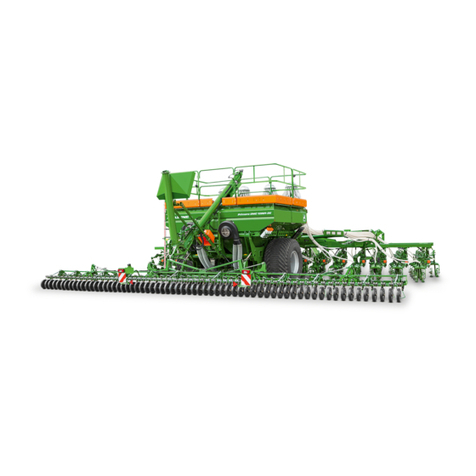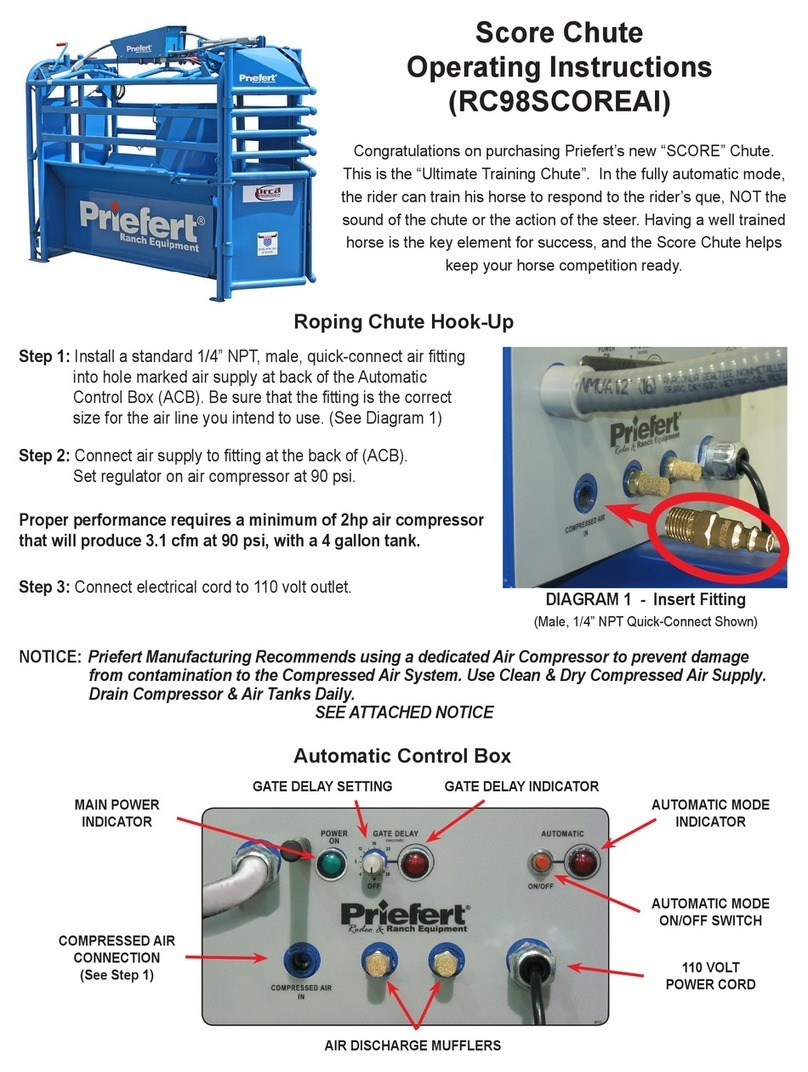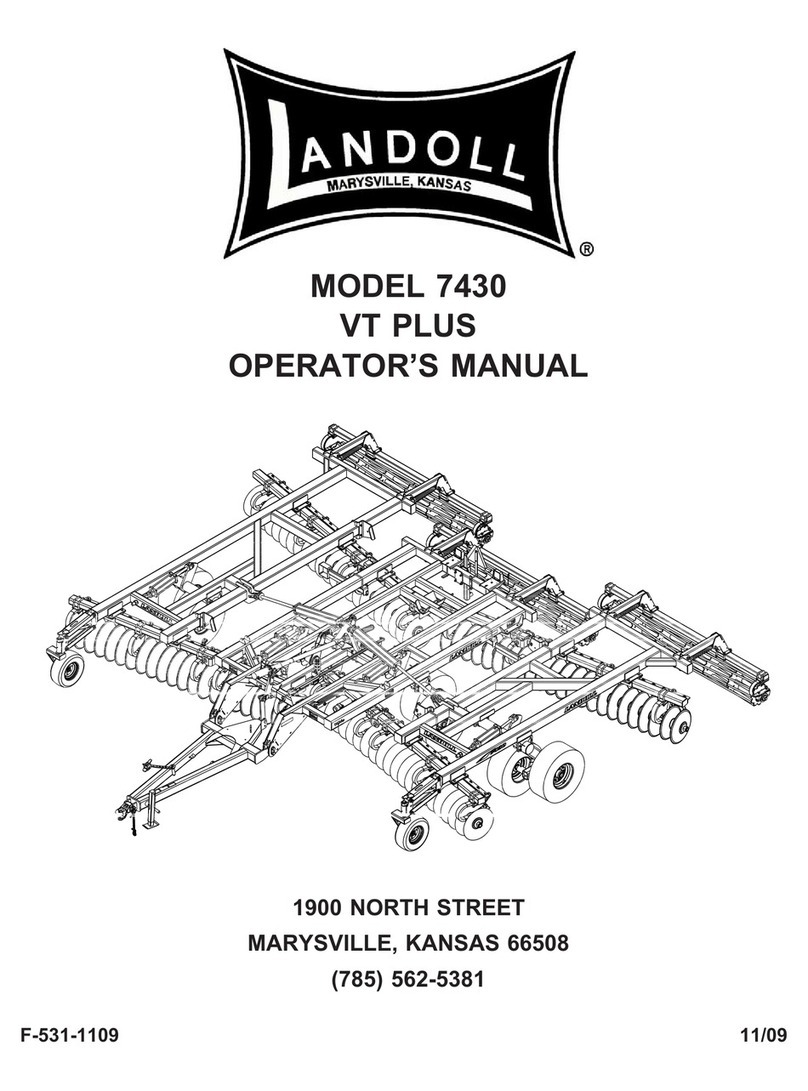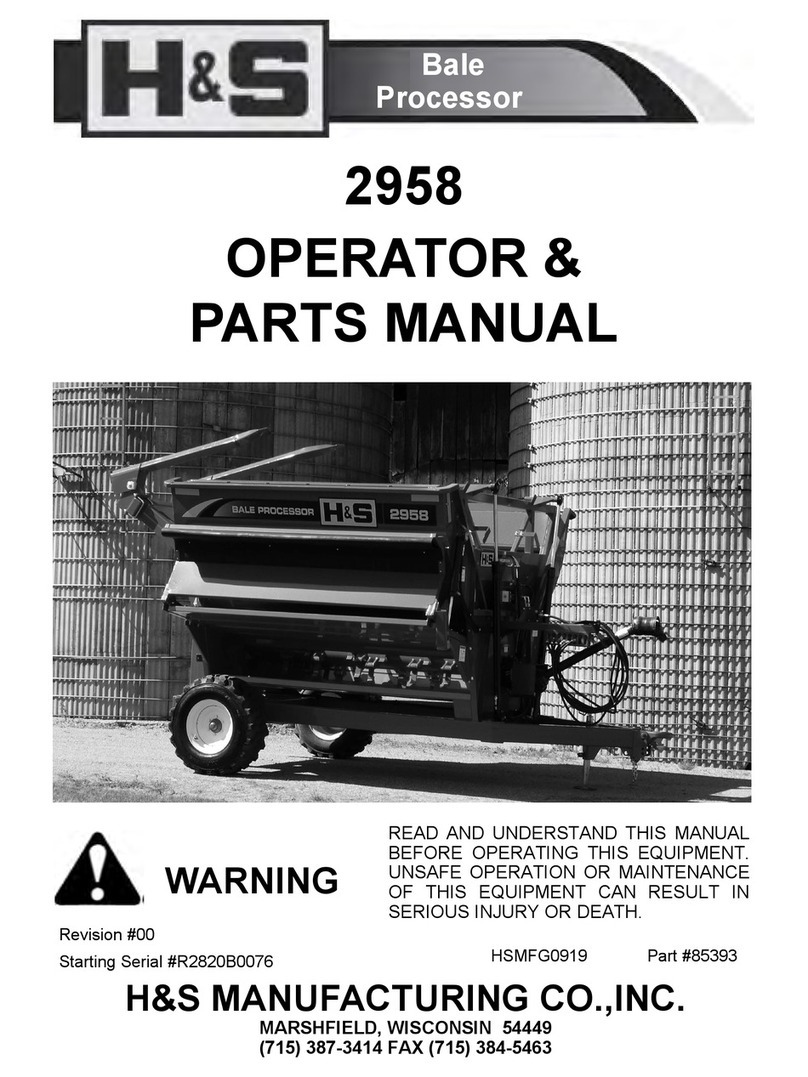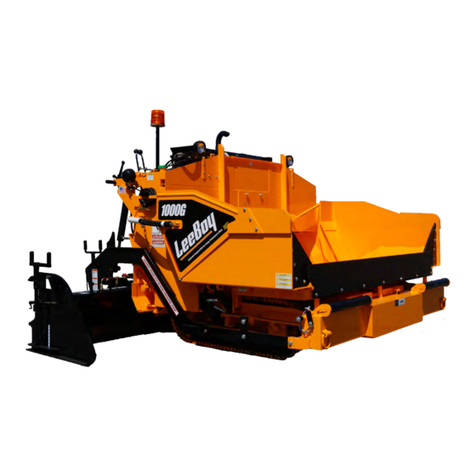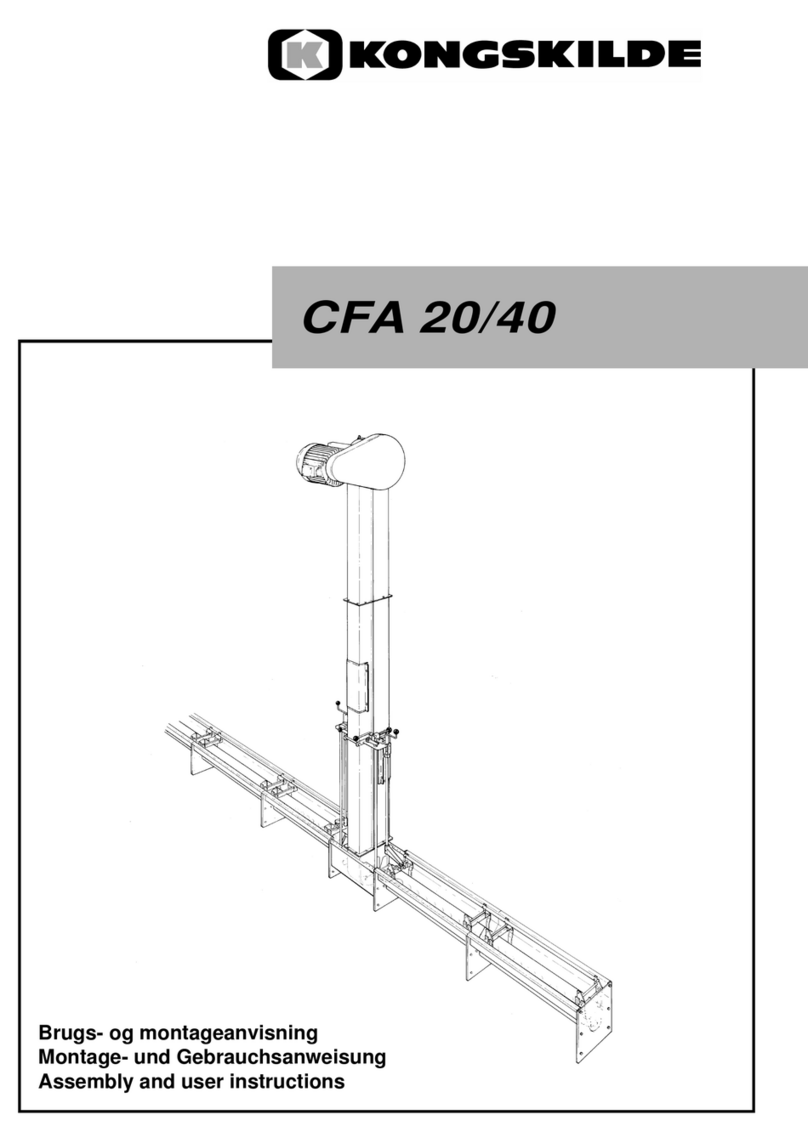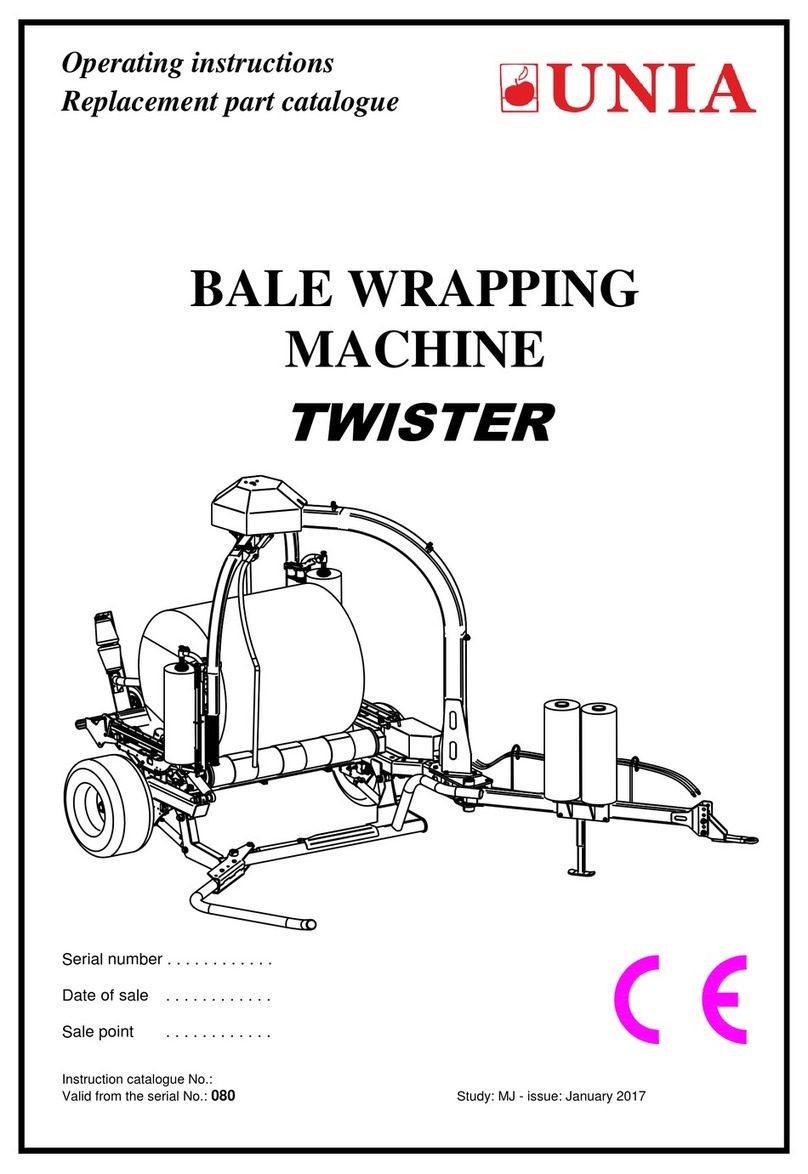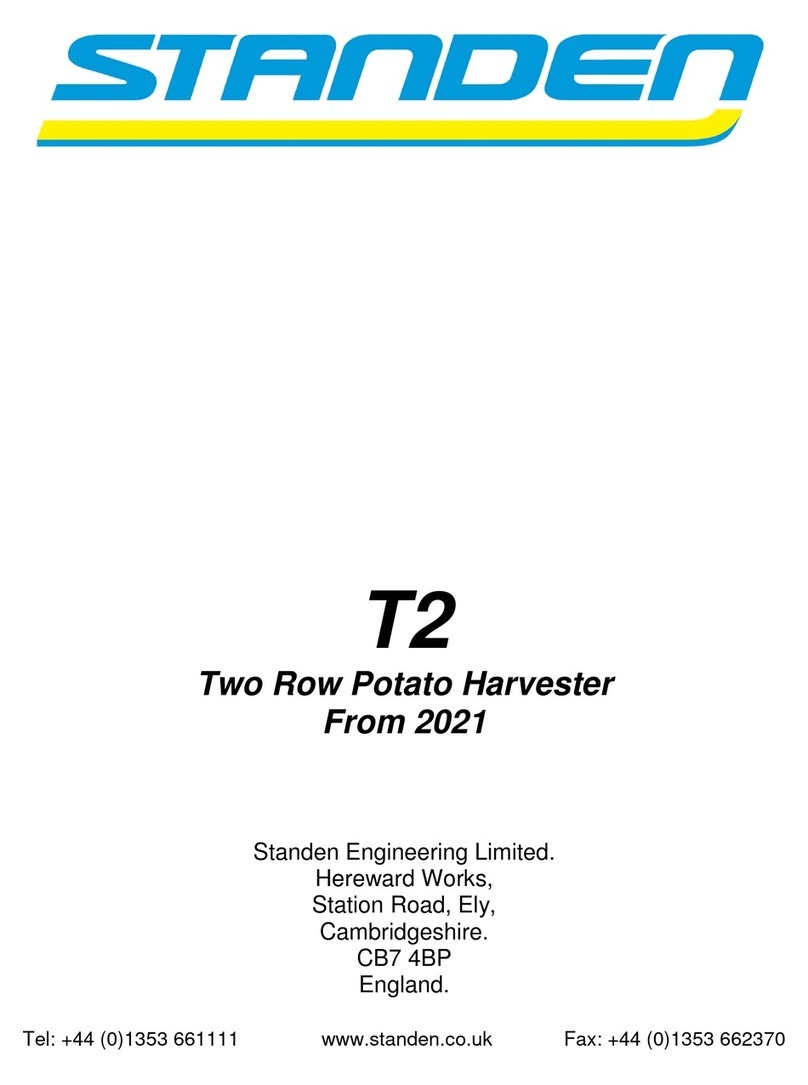Tar River Implements PRZ-3100 User manual

TAR RIVER –401 JEFFREYS ROAD 278404 ROCKY M. –NASH COUNTY (NC)
PRZ-3100
Hay Tedder
OPERATOR’S MANUAL
Rev (07/08/22)

TAR RIVER –401 JEFFREYS ROAD 278404 ROCKY M. –NASH COUNTY (NC)

3
TABLE OF CONTENTS
A
INTRODUCTION
5
A1
INFORMATIONS ABOUT THE MANUAL
5
A2
IDENTIFICATION AND EC CERTIFICATION
5
A3
MAIN COMPONENTS AND TECHNICAL DATA
6
B
SAFETY
7
B1
GENERAL RULES
7
B2
TRANSPORT, INSTALLATION AND MOVEMENTS
7
B3
INTENDED USE AND WARNINGS OF EMPLOY
8
B4
REASONABLY FORESEEABLE MISUSE AND LIMIT OF EMPLOY
10
B5
RESPONSIBILITY OF THE OPERATOR
11
B6
SAFETY LABELS
11
B7
NOISE LEVEL
12
B8
RESIDUAL RISKS
12
C
INSTALLATION
13
C1
HAY TEDDER ASSEMBLY
13
C2
PREPARINF THE TRACTOR
13
C3
HITCHING TO THE TRACTOR
13
C4
CARDAN SHAFT ADAPTATION AND INSTALLATION
14
C5
REMOVAL
14
C6
STORAGE OF HAY TEDDER
14
D
OPERATION AND USE
15
D1
PRELIMINARY INFORMATIONS
15
D2
WORKING CONFIGURATION
15
D3
WORKING PROCESS
15
D4
ADJUSTMENT OF ROTARY UNIT TILT
16
D5
CHANGE OF DIRECTION OF REVERSE
16
D6
END OF WORK
16
E
MAINTENANCE
17
E1
PRECAUTIONS DURING MAINTENANCE
17
E2
MAINTENANCE TASKS
17
E3
TINE REPLACEMENT
18
E4
INSTALLATION OF TINE-HOLDER CLAMP (OPTIONAL)
18
E5
TROUBLESHOOTING
18
E6
MATERIAL DISPOSAL IN CASE OF DEMOLITION
19

4

5
A. INTRODUCTION
A.1 About the manual
The TAR RIVER firm (“Manufacturer”) designed
and created the device in accordance with the
associated safety standards to ensure the safety of
personnel and the entire operating system.
Each hey tedder is supplied with a copy of this
manual which the operator must read in full before
using the equipment. The manual contains all
information relating to transportation, use and
maintenance of the equipment, as well as safety
instructions.
Poor knowledge of the operating system can lead
to accidents and therefore damage to the
equipment. Although the Manufacturer provides the
Customer with all information relating to the hey
tedder operation, use and maintenance, the
Customer is still expected to read this manual and
take note of all the instructions herein.
The manual provides all the necessary instructions
on how to ensure optimal working order and safety.
The manual was drawn up according to the current
technical and structural characteristics of three
models of hey tedder and does not cover previous
similar models. The Manufacturer therefore
reserves the right to modify models in production in
the interest of improvement or due to any new
legislation (Machinery Directive), without being
obliged to modify previous models.
This manual is integral to the hey tedder and must
therefore be kept intact, clean and in good
condition. It should also be in a container, either on
the frame of the hey tedder or in the tractor cabin,
where it can be easily accessed for consultation.
The manual must be kept in its container if the hey
tedder is taken out of service. Ask the Manufacturer
for a duplicate copy if the original manual is lost.
Please contact the TAR RIVER Dealer for any
clarifications relating to the instructions in this
manual.
Symbols used in this manual:
HAZARD or DANGER
Indicates an imminently hazardous situation
that, if not avoided, will result in death or
serious injury;
WARNING
Indicates a potentially hazardous situation that, if
not avoided, could result in death or
serious
injury. It is also used to alert against unsafe
practices.
CAUTION
Indicates a potentially hazardous situation that,
if not avoided, may result in minor or
moderate
injury. It is also used as a reminder of good
safety practices.
IMPORTANT
The operator must take the respective information
into account.
Note indicates that the information referred to can
facilitate the operator work.
A.2 Identification
An identification plate is affixed to each machine:
Type: XXXXXXXX Model
Serial N. XXXXXXX-XX
MFG: 2015 DEL: 2015
You must have this information at hand when
requesting assistance and spare parts.
IMPORTANT
It is strictly forbidden to alter and/or eliminate the
data on the serial plate. The operator must check
the legibility of the data on a regular basis and
inform the Manufacturer if it becomes in any way
illegible. The Manufacturer will then replace the old
plate with a new one bearing the same data.

6
A.3 Main components and technical data
1.
Three-point universal hitch
2.
Cardan shaft coupling
3.
Protective lateral screens
4.
Rotary unit
5.
Tine holder arms
6.
Bearing wheel
7.
Tine
8.
Chassis
9.
Bearing foot
10.
Grade adjusting lever
11.
Towing bar
12.
Manual holder
TECHNICAL SPECIFICATIONS
PRZ 3100
Working width
cm./ ft
310 / 10.2
Transport width
cm./ ft
250 / 8.2
Tine holder arms
nr.
12
Tines - Total
nr.
12
PTO speed
rpm
540
Tractor power
Hp
20
Tractor working speed
km/h
5÷10
Cardan shaft with torque limiter
Nm
600
Tires mounted on chassis - Ballon 15.600-6
nr.
2
Weight
Kg / lbs
193 / 425

7
SAFETY
B.1 General rules
This manual describes the safety regulations to
be followed when using hey tedder. As most
work-related accidents occur due to non-
compliance with the most basic of safety
regulations, it is obligatory to read this manual
before using the hey tedder and to follow all the
instructions.
The equipment must be used by qualified adult
personnel trained in its use. The Manufacturer
cannot be held liable for accidents due to the
operator's negligence and/or non-compliance
with the safety instructions. In this case the
Manufacturer assumes no responsibility and
the warranty is forfeited.
B.2 Transportation, Installation and Movement
Transportation (delivery): the device is fully
dismantled and placed in a crate for
transportation. The TAR RIVER Dealer can
then re-assemble the parts quickly and easily
on receipt, following the detailed instructions.
-In the first case, the equipment used must
have suitable characteristics and slings to
support the hay tedder, which total weight
is indicated on the identification plate.
Trained personnel will perform the
operations, holding the equipment on the
points marked on the frame and provided
for that purpose.
Note: in order to preserve the frame
integrity we recommend holding the hay
tedder with approved straps instead of
chains. However, on the
points where it should be
held an adhesive label
was applied, containing a
hook (as shown in the
figure), to highlight the
use.
-in the second case, by using a forklift or
a tractor, the equipment is pushed, in
reverse, on the vehicle platform
In both cases, the equipment, once placed on
the truck, will be anchored to its structure and
equipped with all the safety gear needed for
transport.
IMPORTANT
Do not forget that, for transportation and
handling, the hey tedder must be in its
transport configuration as described in the
chapter “Moving the hey tedder”.
HAZARD
Loading and unloading operations always
represent situations of danger, is
therefore necessary that the operators,
always act with caution.
Always take the following precautions:
-Loading/unloading must be carried out
on a flat surface and at a safe distance
from slopes or ditches;
-Always make sure the ramps are strong
enough to withstand the hey tedder
weight (see the specification table shown
in this manual), are firmly attached to the
vehicle and are parallel to each other and
perpendicular with the edge of the
vehicle;
-Ensure the ramps are clean, without any
traces of oil, grease or ice;
-Never change direction when moving hey
tedder onto or off the vehicle. If
necessary, move hey tedder back down
the ramp to turn it around.
For long distances travels the equipment is
dismantled and lies within a wooden casing.
Detailed instructions allow the Customer,
upon receiving the parts, to assemble the
hay tedder with ease and speed. So, if the
machinery is to be sold or transferred to
another user, for disassemble operations just
follow the instructions in reverse order.
Installation: the hay tedder must only ever
be attached to an agricultural tractor with
hitch, auxiliary universal three-point coupling
and hydraulic lift.
IMPORTANT
The tractor must also, by law, be fitted with a
protective roll-bar or ROPS or FOPS cabin. It
is strictly forbidden to install the rake on a
tractor without the required protection
equipment.
Prior to installation, however, the Customer
must check the tractor operating and
maintenance manual to make sure the tractor
is compatible with rake, and whether ballasts
are needed to prevent unbalance that could
cause it to tip over..
For the hay tedder installing instructions and
any hydraulic and electrical connections refer
to the relative sections described below.
For the cardan shaft instructions, refer to the
ones attached to the part.

8
Movement on road: the hay tedder must be
hitched to the back of an agricultural tractor.
The complete vehicle (the tractor with hay
tedder) does not require any luminous or
acoustic signalling devices or panels when
used in cultivated fields. However, you must
do the following for road circulation:
-tine positioning: by turning the lever
counter to reset the rotary unit tilt in
respect to the ground;
-warning lights: the tractor must
obligatory have the beacon warning light
(yellow or orange) always activated. In
addition, if the hay tedder bulk hides the
visual signalling and lighting devices on
the tractor, they must be duplicated,
applying a special bar at the back of the
machinery;
-hay tedder weight and tractor speed: it
is necessary consider the total weight of
the machinery (tractor and hay tedder)
and its load (hay tedder). The tractor
must be heavy and powerful enough with
special braking power for the towed load.
Ensure the load does not exceed the
recommended weigh ratio. Add ballast to
recommended maximum for tractor,
lighten the load or get a heavier towing
unit;
Stopping distance increases with speed
and weight of towed load and,
particularly, on slopes. Towed loads (with
or without brakes) can be both heavy for
the tractor and towed fast. In both cases
they can cause loss of control.
Follow to:
if towed equipment does not have
brakes, the tractor speed cannot
exceed more than 32 km/h (20 mph)
and the tow-load weight cannot
exceed more than 1.5 times of
tractor’s;
if towed equipment has brakes, the
tractor speed cannot exceed more
than 40 km/h (25 mph) and the tow-
load weight can not exceed more
than 4.5 times of tractor’s.
Use additional caution when towing loads
under adverse surface conditions, when
turning and on slopes.
-Laws: you should know and comply with
the laws on road circulation in your
country
When circulating on road with the operating
machine (tractor with hay tedder), the
operator in the cabin must always observe
the following precautions:
-do not carry passenger on the tractor;
-do not carry on the equipment people,
animals or things;
-PTO must always be disengaged.
Movement on field: when on fields with the
operating machine (tractor with hay tedder)
there is no need to turn on any lights or
sound or to display any type of panel.
B.3 Intended use
The hay tedder is an agricultural equipment used
to spread, aerate and turn over any type of
previously cut forage, so as to allow an early and
uniform drying of the product which ensures a
high-quality forage. Once completely desiccated,
it is harvested by a baling press.
The hay tedder operates only if connected the
tractor towing hook. Both models operate in result
to the tractor drag effect that pulls them and to
the rotation effect of the working units, provided
by a cardan shaft applied to the tractor PTO.
Each of rotating working units (two) is composed
by six arms on which working tools or tines are
installed. The units rotate, one in opposition to
the other, with a pronounced tilt toward the front
(7 ÷ 10°), so that the product is harvested from
the tines and thrown up in the back spreading on
the land.

9
The movement of the side sections (from the
working configuration to the transport one) is
obtained by hydraulic cylinders. The adaptation
to the ground of the tines (smaller or greater
forward grade of the six units) is performed by a
hydraulic cylinder. In this case, the cylinder is
supplied by the auxiliary hydraulic circuit of the
tractor, through piping equipped with quick
couplings, and therefore controlled by a
correspondent lever in the cabin.
The hay tedder must be used only by qualified
operators and trained for its use and operation.
Safety is of prime importance for the personnel
who use the equipment or who perform repairs or
maintenance. Given that the provided
instructions cannot cover all possible working
situations and related dangers, personnel should
always use caution and common sense.
The operator (tractor driver) must always check
that no people or animals go in the dangerous
zones of the equipment (shown in figure),
because they are not conscious of possible
dangers.
Before starting the tractor and begin working,
it is important:
-verify that the equipment has been correctly
installed on the tractor;
-verify that all locking and safety devices are
present and undamaged;
. -verify that the power takeoff is disengaged
and that the tractor PTO number of
revolutions per minute is 540 and that the
sense of rotation is clockwise;
IMPORTANT
The power takeoff must never be engaged
when the engine is switched off and if
between two cardan universal joints
(tractor /hay tedder) there is a grade more
than 10°;
-verify that the cardan shaft is properly
installed and that all blocking and safety
devices are present and integral. If one of
these was not integral or a not approved
device was installed, the Manufacturer
cautions the Customer in not using that
shaft since it is prohibited;
-do not use the equipment if there are broken
or damaged parts, especially of protective
ones;
-perform the daily maintenance (as described
in the relative paragraph). Concerning this,
remember that any type of task (control,
adjustment, maintenance or other) should
always be performed with the equipment
not in motion, the PTO disengaged and
the tractor engine switched off;
-check the tine grade in respect to the ground.
If any adjustment is required, refer to the
specific sections described below;
-hay tedder operations are allowed in good
visibility conditions. In the event that
these conditions were absent, even
partially, operations should be interrupted
since even the normal safety conditions are
absent. The operations can be resumed
10° max
TRACTOR
PTO
EQUIPMENT
PTO
DANGEROUS
ZONE
DANGEROUS ZONE
DANGEROUS ZONE
DANGEROUS
ZONE

10
only if good visibility conditions are
restored.
Precautions when using:
-the tractor must proceed in straight line,
avoiding abrupt movements (sudden
accelerations and/or changes of direction).
The tractor speed must not exceed the
limit of 10 - 12 km/h (6.2 - 7.46 MPH);
-any adjustment, check, control and
maintenance task must be performed with
the tractor stopped, with its engine off and
with the ignition key removed from the
dashboard;
-the operator in the tractor cabin must never
abandon the tractor leaving its engine on.
Even for short working breaks, they must
always stop the tractor, switch off its engine
and remove the ignition key from the
dashboard;
-before reversing with the tractor or for
direction changes at the end of the field, the
operator must necessarily place the
equipment in transport configuration, lifting
the tines of central rotary units from ground.
The hay tedder could suffer serious damage
if the teeth were not raised (see also section
“Change of direction or reverse”);
-the hay tedder operation does not produce
enough noise to allow the use of the
acoustic protections (earplugs, earphones,
etc.), instead the tractor can produce it.
Therefore, consult the use and maintenance
manual of the tractor;
-the vibrations that the equipment may
produce and transmit to the operator are of
low intensity and the frequency is below
human tolerability levels. However, it is
good always to keep the transmission
and the gears well lubricated.
Immediately interrupt work operations if:
-you are in proximity of resistant objects,
such as manholes, wells, trees, etc. since
contact could break the tines, and projected
the pieces all around at high speed;
-noisy vibrations coming from the equipment
are heared. To avoid possible damages, the
operator should stop the tractor, disengaged
the PTO, switched off the engine and if
possible, identify and remedy the situation,
always in respect with safety regulations.
B.4 Reasonably foreseeable misuse and limit of
employ
A different use from that one described in the
previously paragraph is considered improper
and therefore forbidden. In addition, the
technical characteristics of the equipment must
not be modified in any way to alter its
performance. In this case, both the equipment
warranty and the Manufacturer liability would
immediately become void.
Visibility: in conditions of insufficient visibility
(fog, dust, smoke or other): it is advisable to stop
the tractor and to wait until that fog, dust or other
goes away. If this must not occur it is necessary
that the working process is interrupted and the
tractor goes in a parking place by using its
lighting devices. Operate at the same way in
case of rain.
Changes of direction or reverse: when to the
end of the field the machinery must invert the
traveling direction, the operator in cabin
must stop the tractor and then to provide to
put the equipment in transport configuration
and to carry out the manuever of travel
reversal.
Slope: a high slope can cause the tractor
rollover. Do not work on grounds with slope
greater than 15 degrees because it is very
dangerous.
Vibrations: it is important to keep the
transmission devices and the gears always
lubricated. Furthermore, it is opportune to verify
often that the bolts are tightened so as to avoid
vibrations.
Dangerous zone: if, during the working process,
a people or an animal go in one of the
dangerous zone (see previously paragraph), the
tractor driver must immediately stop the working
process and provide to distance the intruder. At
the same way, during the adjusting and/or
maintenance tasks, the outsiders must not stay
or move in the proximity of the equipment.
Do not use the machinery if:
The cut product is wet or damp. Under these
conditions, it becomes sticky and easily
accumulates on tines, limiting them operational
function.

11
HAZARD
No operations should take place in masonry
proximity. In these cases apart from the
possibility to damage the tines could also be a
dangerous projection of relative residues.
For any doubt about the use of the hay tedder and
not included in this manual please contact the
Manufacturer.
B.5 Responsibility of the operator
Each operator becomes liable for the damages
caused to themself, others, animals or damages
to the things if they proceed with an incorrect use
of the equipment and/or not conform to the
instructions contained in this manual.
Consequently, the responsibility of the
Manufacturer would immediately be void if
the operator:
-use the equipment in improper or incorrect
way;
-has not been property trained or has not
read the operator instructions in this manual;
-use the equipment while under the influence of
alcohol, drugs, or in a state of tiredness or
sickness
-does not respect the current road norms;
-not having previously verified the required
requirements, the coupling of the equipment
to the tractor is not suitable (different power
or characteristics to the those ones
indicated in the table of the technical data);
-has not performed the foreseen
maintenance tasks;
-has modified the equipment;
-has used non original spare parts or not
right for the model.
-do not wear radio or music headphones
while operating machine;
-wear close fitting clothing and safety
equipment appropriate to the job.
HAZARD
Each operator must know that the direct
contact and/or exposure to hazardous
chemical (as lubricants, coolants, paint and
adhesive) can cause
serious injury.
A Material Safety Data Sheet (MSDS) provides
specific details on chemical products: physical
and health hazards, safety procedures and
emergency response techniques.
Before starting any job
using a chemical product of
these above mentioned,
each operator must consult
the MSDS to know exactly
the associated risks and
how to do the job safely.
B.6 Safety labels
In addition to the instructions contained in this
manual, adhesive labels have been applied on
various parts of the equipment to help operators.
These labels illustrate the safety rules that
should be observed.
The shape and color of the labels vary based on
the rules. In addition to containing a danger or
prohibition sign, other rectangular labels provide
additional information about the safety rules that
must be observed. The rules illustrated by the
labels affixed to the equipment (fig.11) are as
follows:
1. Prohibition of stopping or transit. It is
prohibited to others than authorized
personnel to stop or transit in the hay tedder
proximity, when it is running. Remain at a
safe distance (m. 20);
2. prohibition to perform repairs or
maintenance with parts in motion. It is
absolutely forbidden to adjust, lubricate,
repair or replace parts in motion. These tasks
must be performed with the P.T.O.
disengaged, the tractor engine off and the
ignition keys removed from the dashboard;
3. verify that the number of revolutions at
the tractor PTO exit is of 540 rpm and that
the rotation is clockwise;
4. obligation of reading the use and
maintenance manual;
5. danger to be hooked or to get caught on.
With the rotation of arms, the tines may hook
clothes or other objects worn by staff. -
danger of flying objects. With the rotation
of arms, the tines could pick up and throw
objects form the working site. Minimum
safety distance m.20

12
IMPORTANT
The safety and instruction labels must be
replaced before they become illegible. If this
happens, the operator cannot use the hay tedder
until a new label is applied. Similarly it is utterly
forbidden to remove the safety or instruction
labels placed on the machine. In any
circumstances in which this occurs the
Manufacturer disclaims all responsibility because
the machine would not meet the safety
standards with which it was designed and
Manufactured.
The labels similar to these present on the
equipment are available from the Manufacturer.
Call the Customer service of TAR RIVER Dealer
to ask for replacements. It is advisable, during
the equipment delivery verify the presence and
the status of the labels.
B.7 Noise levels
The device produces little noise other than that
of its moving mechanical parts and has no
motor. Therefore, the operator does not need
any acoustic protection (ear plugs, muffs, etc.).
As for the noise produced by the tractor, to
consult the proper operator’s manual.
B.8 Residual risks
Lower limbs and/or bodily injuries: loss of
stability in phase of parking caused by the non-
installation of the bearing feet.

13
C. INSTALLATION
C.1 Hay tedder assembly
As already said, the hay tedder is fully
dismantled for delivery to the Customer. The hay
tedder can be assembled quickly and easily
following the relative instructions (at the end of
this manual). Assembly must be performed on a
flat surface prepared especially for the purpose.
The hay tedder, once it has been assembled,
can be installed or hitched to a tractor.
C.2 Preparing the tractor
The hay tedder can be attached to any tractor
having a drawbar that conforms to ASAE-SAE
standards of 330 to 559 mm (13 to 22 in.)
(fig.12-A) from the ground.
C.3 Hitching to the tractor
The operator must move the hay tedder slowly to
a position where the joints can be easily aligned
(fig.13-3.1).
IMPORTANT
The holes in the tractor attachment must be
aligned with those on the hay tedder attachment
with maximum care and attention.
When the tractor is near the hay tedder coupling
point, an operator on ground, manually raises or
lowers the hay tedder coupling point in order to
make it horizontally coincide with the tractor.
After the coupling, the operator inserts the
locking pin (3.2) in the corresponding holes of
coupling point, as shown in the figure, and then
secures it with the safety pin (3.3).
C.4 Cardan shaft adaptation and installation
Installation: follow thoroughly the installation
instructions reported on its own use and
maintenance manual.
IMPORTANT
Before installing the cardan shaft make certain
that it suits the requirements concerning the
type and the power to be transmitted
depending on the tractor’s PTO speed. If
necessary also check the tractor’s user
manual.
When not utilized, i.e. when not attached to
the tractor PTO but only to the hay tedder,
place the shaft on the support provided for
this purpose on towing hook bar.
Adaptation: the cardan shaft (either
supplied with the equipment or sold
separately as an accessory) is standard
length. It is therefore necessary to adapt it
according to the tractor on which the hay
tedder will be installed. For this operation,
proceed as follows:
Fig.12
3.1
3.3
3.2
Fig.13
Fig.13

14
-remove the cardan shaft protections;
-pull out the two halves that make up the
shaft and attach one half to the hay
tedder PTO, triggering the safety spring
pin, and the other half to the tractor PTO,
also triggering the safety spring pin;
-place the two halves one next to the
other and find the minimum flowing
length (L). If the shaft is too long, first cut
in equal measures the two external
plastic protection tubes and then the
internal metal ones. File the cut parts
and lubricate the internal parts.
IMPORTANT
When the cardan shaft is pulled out to the
maximum, the two tubes must overlap by
at least 15 cm. When it is inserted at the
maximum, the minimum backlash
allowed must be 4 cm.
-remove the two halves of the cardan shaft
from their joints (on the tractor and on the
hay tedder) and reconstruct the shaft,
putting one half in the other completely;
-connect again each end of the cardan
shaft to the respective PTO triggering their
safety spring pins;
-block the protection tubes with the special
chains, respectively, on the hay tedder
and on the tractor in order to prevent
them from rotating. The overlap between
the guard and the cardan shaft must not
be less than 5 cm.
At this point, without activating the tractor PTO,
the equipment can be transported to the place of
use.
Note: if the equipment is used with a different
using the tractor, the cardan shaft may need a
readjustment. Proceed with the instructions
described in this paragraph.
C.5 Removal
For the hay tedder removal from the tractor follow
the instructions contained in the previous
paragraph, in reverse order.
C.6 Storage of hay tedder
The Customer must provide, within his company,
the equipment storage area, making sure it has a
wide and easy access. For the hay tedder
storing, the following interventions are needed:
-if not already done, place the hay tedder into
transport configuration;
-put the bearing feet (front and rear) for the
parking phase;
-park the equipment in a safe and secluded
area, on a flat and solid surface;
-remove the tractor from the hay tedder;
-protect the equipment with a cloth.
MAX
MIN
Min 4 cm Min 15 cm cm 5

15
D. OPERATION and USE
D.1 Preliminary informations
An appropriate and optimal use of the hay tedder
serves not only to prevent damage and/or injury,
but is the only way to get the same high
performance and to discover its true potential
and performance.
Before each start-up of the tractor, it is important
to scrupulously follow the precautions described
in the chapter “Safety”. Remember that the hay
tedder is to be used by a qualified operator, of
age and trained for its use and operations.
Consequently, he must know perfectly the
instructions in this manual, all those reported on
the adhesive labels and all the safety regulations
for his and others' safety and to safeguard the
equipment.
D.2 Working configuration
The hay tedder will be driven to the workplace
according to the regulations described in the
chapter “Safety”, and
before using the
equipment, verify that
the tractor PTO is
disengaged. Rotation
speed: 540 rpm.
IMPORTANT
The PTO should never
be engaged while the
engine is off;
After that, the operator provides to:
-verify the tine inclination in respect to the
ground is correct. For any adjustments
consult the paragraph “Adjustment of rotary
unit tilt (page 16);
-verify that NO people or animals in one of the
equipment dangerous areas (or range), if not
provide to send them away;
-Get back on the tractor, start the engine and
release the parking brake and by acting on the
corresponding lever, engage the PTO..
D.3 Working process
With the tractor proceeding and the rotation of
working rotary units and therefore of the tines,
the hay aeration process begins.
The tines skims and scrapes the ground surface
and harvests the cut crop pushing it rear upwards
in order to spread it evenly. For best results the
rotary units
must operate at an angle to the ground, which
can vary from 7 to 10°, as shown in figure.
Operate for a few meters and then check the
result of the process. If the operator deems
appropriate to increase or decrease the angle of
the rotary groups to the ground so as to improve
the working process, follow the relative
instructions in the next paragraph.
In presence of a lot of forage and/or of damp
forage adjust the rotary groups to the maximum
inclination B. Use the inclination Ain presence of
little forage and/or dry.

16
During operations, always maintain the tractor
speed within 5÷10 km/h. The optimum number of
PTO revolution is around 450 rpm.
IMPORTANT
Except for cases where otherwise specified, all
adjustments must be performed with the tractor
engine off, the PTO disengaged, the parking
bhey tedder pulled and the ignition key removed
from the dashboard.
D.4 Adjustment of rotary unit tilt
To modify the rotary unit tilt in respect to the
ground operate on the special adjusting lever, as
shown in figure. By turning the lever counter
clockwise (1direction) the inclination increases.
Turning the lever clockwise (2direction) the
inclination reduces.
D.5 Change of direction or reverse
At the end of the field when the tractor with the
hay tedder must reverse the direction of
movement or in the case it has to go for a short
distance in reverse, is essential that the tines are
lifted from the ground and when needed the
equipment has to convert into the transport
configuration (consult the following paragraph).
By turning the lever counter to reset the rotary
unit tilt in respect to the ground.
D.6 End of work
At the end of work, if a tractor has to go back in its
usual parking place, make the hay tedder assume
the transport configuration before moving.
Therefore:
disengaged the P.T.O.;
switch off the tractor engine;
pull the parking bhey tedder;
put the gear lever in neutral position;
remove the ignition key from the dashboard;
For the storage of equipment follow the
instructions described in the related paragraph.
2
1

17
E. MAINTENANCE
E.1 Warnings during maintenance
The hay tedder is agricultural equipment that
does not require special maintenance, nor
relative programs. However, there is a regular
intervention, described below, which, if done with
care by the Client, will keep unchanged the
efficiency and the working capacity of the
machinery avoiding any operating damage.
The operator, which must be of age, qualified and
trained to perform such interventions must
necessarily observe what follows:
HAZARD
-any type of intervention has to be
performed on a flat surface, sufficiently
lit and clear of people, animals or things
that might hinder the manoeuvre. The
equipment must be placed firmly on the
ground, the tractor blocked, the parking
brake pulled, the engine switched off and
the ignition key removed from the
dashboard. Should it be necessary to lift
the hay tedder, it is appropriate to secure
it by placing beneath pieces of wood or
metal, as shown in figure;
-before operating, for his safety and to
prevent damage to the hay tedder, he must
apply, well in view on the tractor dashboard,
the warning sign "Machine under
Maintenance”;
-both maintenance and repair operations,
once started, must always be finished and
never postponed;
-he must rely on his memory, but always read
the instructions in this manual and execute
them accurately;
-the use of equipment to perform
maintenance work is subjected to the
accident prevention.
At the end of maintenance or repair operations,
remove from the area any water, oil, grease oily
rags, tools or other material that may be present.
E.2 Maintenance tasks
The intervention times are for information only
and refer to normal conditions of use. Therefore,
they are subject to changes in relation to the kind
of service, the environment in which the work is
done (more or less dusty) seasonal factors etc.
The more the machinery conditions are
burdensome, the more the interventions must be
increased.
The maintenance tasks to be performed every
week or after 40 operating hours are:
-refuelling of grease by using the specific
pump, in all the grease nipples present on the
equipment and identifiable through the
adhesive labels like the one shown on the side
and sticked in their proximity. Grease agip MU
EP 2;
-check the fastening of nuts and screws that
secure the various parts of the equipment;
-check for the presence of the various safety
pins and R cotter pins that lock the various
parts of the equipment;
-verify that the structural integrity of all the
equipment parts especially those more
subject to wear such as wheels tires;
-check the integrity of the rotary units and that
the transmission gear box does not present
any oil leakage.
Note: all types of hay tedder have an oil
immersed transmission gear box which
means that all internal components operate
immersed in the lubricant..
Consequently, they are subject to a rapid
wear out if the oil runs out and therefore to
seizure. Therefore, if from the box any loss
or leakages are to be verified, it is essential
to check the inside oil level.
To check simply unscrew the cap level on
the side of the head as shown in the figure. If
the oil level does not reach the bottom of the
hole, its quantity is to be considered
insufficient and its refilling must be operated
through the same hole until the oil begins to
overflow.
GREASE
NIPiPLE
LUBRICATING
POINTS

18
Use only ISO VG 320 (ENI BLASIA 320)
gear oil (CINCINNATI MILACRON | DAVID
BROWN S1.53.101 (5E) | DIN 51517 Parte 3
- CLP | ISO L-CKD | U.S. STEEL 224)).
IMPORTANT
To avoid pollution, it is absolutely forbidden to
dispose of oils, lubricants, filter cartridges or
other harmful materials into the environment.
Strictly follow the regulations in force for the
disposal of liquid and solid substances.
For what concerns the cardan shaft interventions,
refer to what is described in its use and
maintenance manual
E.3 Tine replacement
If tine replacement were necessary (worn or
broken), you must completely unscrew the
locking nut (5), extract from its seat the fastening
screw (3) with its tine-stop plate (2) and then pull
the pair of teeth (4) from the equipment arm (1).
Insert a new pair and proceed in reverse order
the phases described for the removal.
E.4 Installation of tine-holder clamp (optional)
Protective clamp in case of breaking up of a tine.
To insert the clamp (1) from the lower part, to
position it after the bending of the tines (as in
figure) and to stop it with the respective locking
screws and nuts (2).
E.5 Troubleshooting
FAILURES
CAUSES
REMEDIES
Partial or insufficient forage harvesting
Tines too high from the ground
Adjust working rotary unit tilt (see
paragraph page 16)
Tines rapid wear out
The tines are continuously in contact
with the ground
Adjust working rotary unit tilt (see
paragraph page 30)
1
2

19
E.6 Material disposal in case of demolition
When the hay tedder is placed out of service, we
need to make harmless the parts that could
become dangerous for people, animals and
the environment, if dispersed. The materials of
the equipment, which are subjected to a separate
subdivision are:
iron
lubricating oil
rubber
Disposal of these materials must be done
according to the regulations of applicable law, in
force in each Country.

20
Table of contents
Other Tar River Implements Farm Equipment manuals
Popular Farm Equipment manuals by other brands
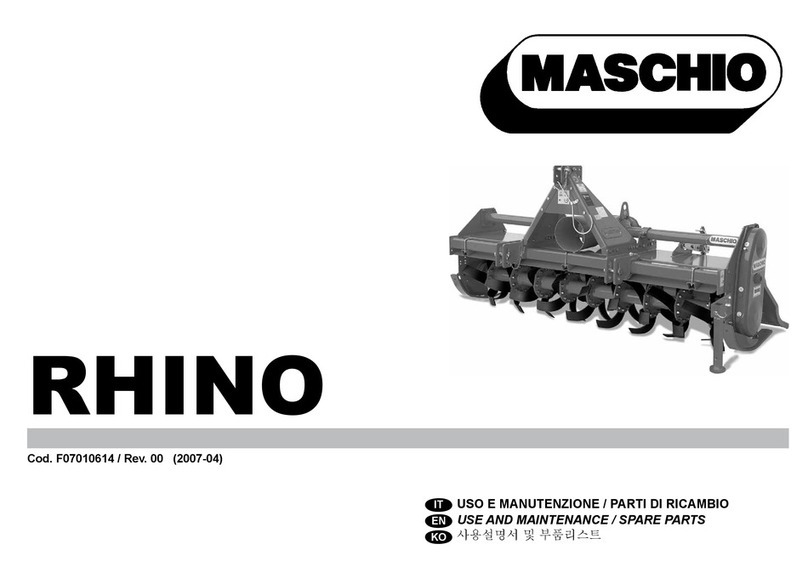
Maschio
Maschio RHINO Use and maintenance / spare parts
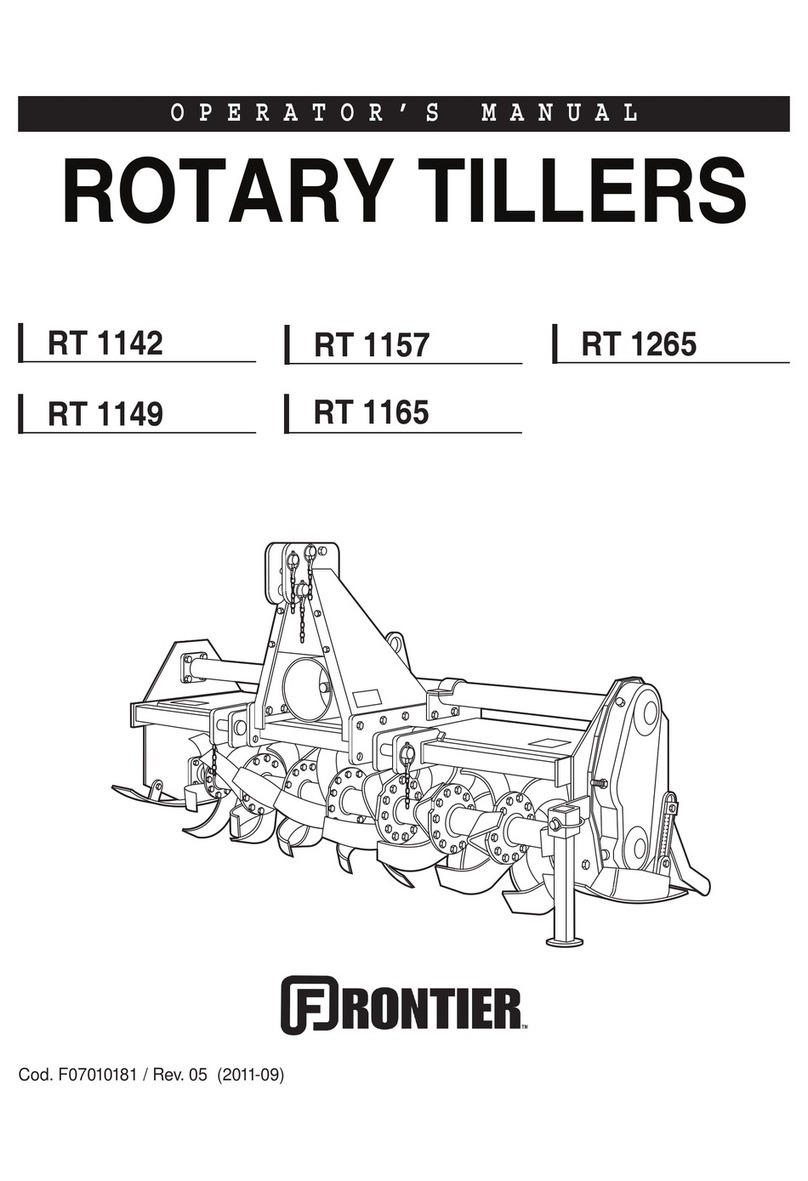
Frontier
Frontier RT 1142 Operator's manual
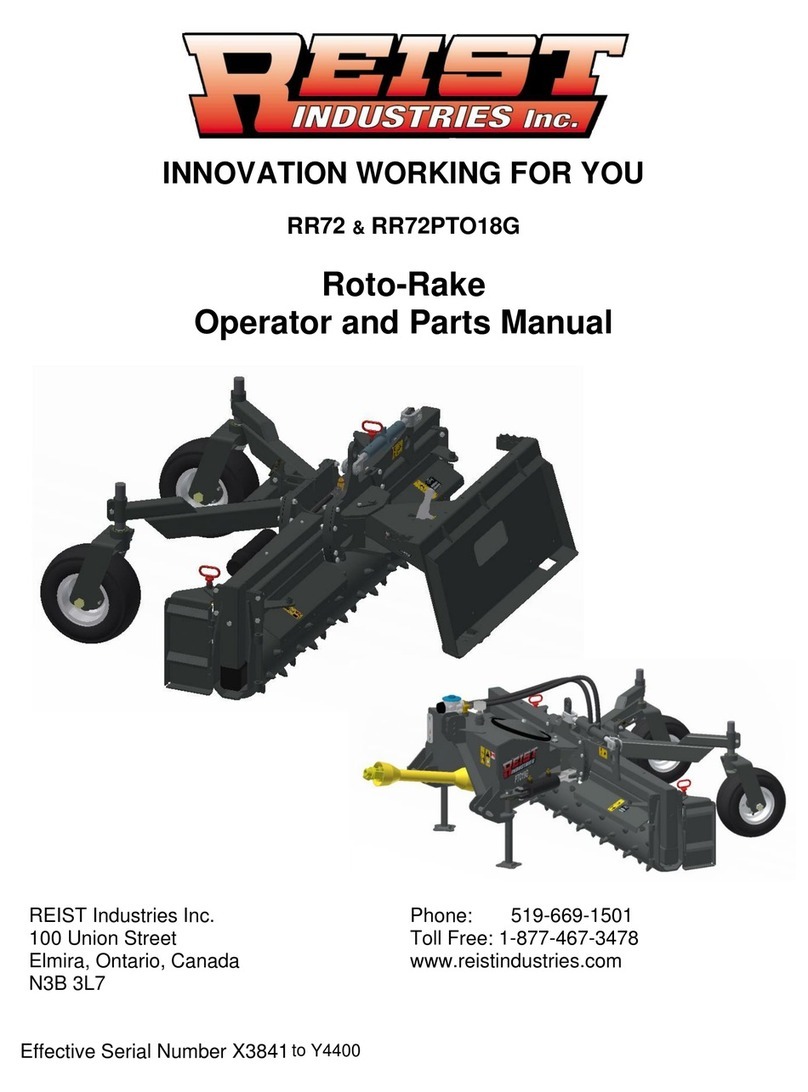
REIST INDUSTRIES
REIST INDUSTRIES RR72 Operator and parts manual
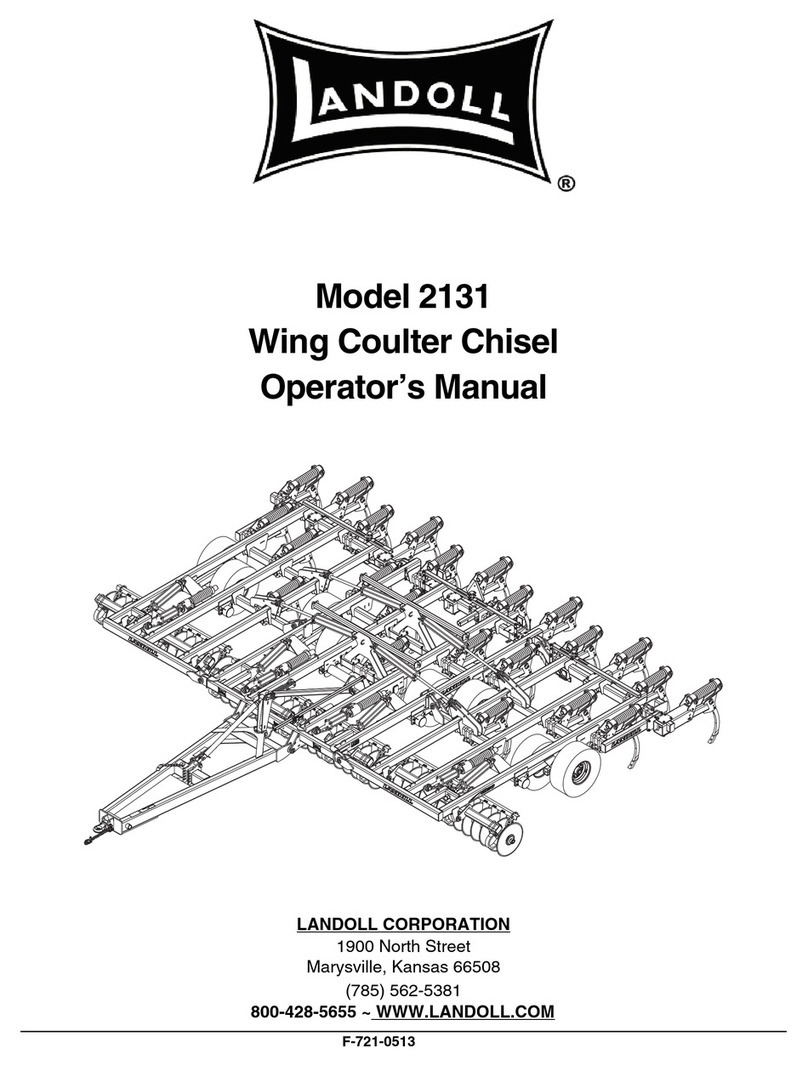
Landoll
Landoll 2131 Operator's manual

pronovost
pronovost SilaTube P-6500 Operator and parts manual
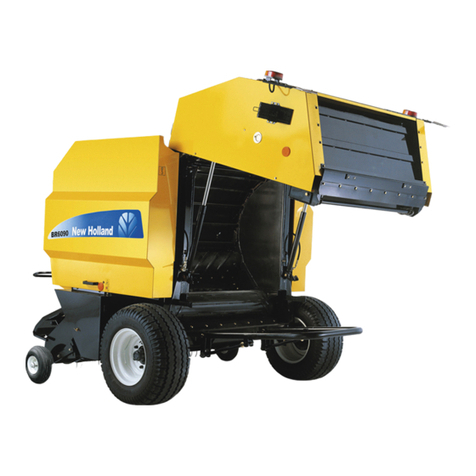
New Holland
New Holland BR6080 Operator's manual
